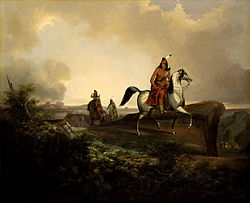Baishan (Apache)
| Baishan | |
|---|---|

Black Knife, painting by John Mix Stanley, 1846.
|
|
| Tchihende Apache leader | |
| Personal details | |
| Born | c. 1795 |
| Died | 1850 or 1857 (?) |
| Known for | Chief lieutenant of Mangas Coloradas |
| Nickname(s) | Black Knife, Cuchillo Negro, Knife |
Baishan, Spanish name Cuchillo Negro (Black Knife) (c. 1796 – May 24, 1857), was a Chihenne (Mimbres) Apache chieftain, of the Warm Springs Apache Band during the 1830s to 1850s.
Baishan (“Knife”), son of the famed chief Fuerte aka Soldato Fiero, was a most respected war leader among the Tchihende bands along almost three decades from the beginning of 1830s, and the principal chief the Warm Springs local group of the Tchihende ("Chihenne") Apaches after Fuerte's death in 1837 near Janos; he was also the second principal chief of the whole Tchihende (or Mimbreño) Apaches after his long-time companion Mangas Coloradas, chief of the Coppermine local group of the same Tchihende (or "Chihenne") Apaches. His name was translated by the Mexicans as Cuchillo (“Knife”) or - because of the Apache practice of blackening their weapons to make them less conspicuous - as Cuchillo Negro (“Black Knife”). Cuchillo Negro's name is mentioned in military and civilian records of treaties and other dealings with Apaches during the early years of U.S. jurisdiction over the New Mexico Territory. The U. S. Army claims he was killed in the Black Range by Pueblo scouts, under Col. William W. Loring, during the Bonneville Expedition in 1857. However, the Fort Sill Apache, Chiricahua - Warm Springs Mimbreño Apache website says he "Died in the revenge raid on Ramos (1850)."
Several geological features in Sierra County, New Mexico bear his name: Cuchillo Negro Mountains, Cuchillo Negro Creek, and the town of Cuchillo, New Mexico.
A painting of Cuchillo Negro on horseback was done by John Mix Stanley in 1846. The painting hangs in the Smithsonian American Art Museum. It measures 42 1/2 x 52 in. (107.8 x 132.1 cm). Since Apaches traditionally did not wear feathers in this way there is some doubt the artist ever saw his subject.
...
Wikipedia
